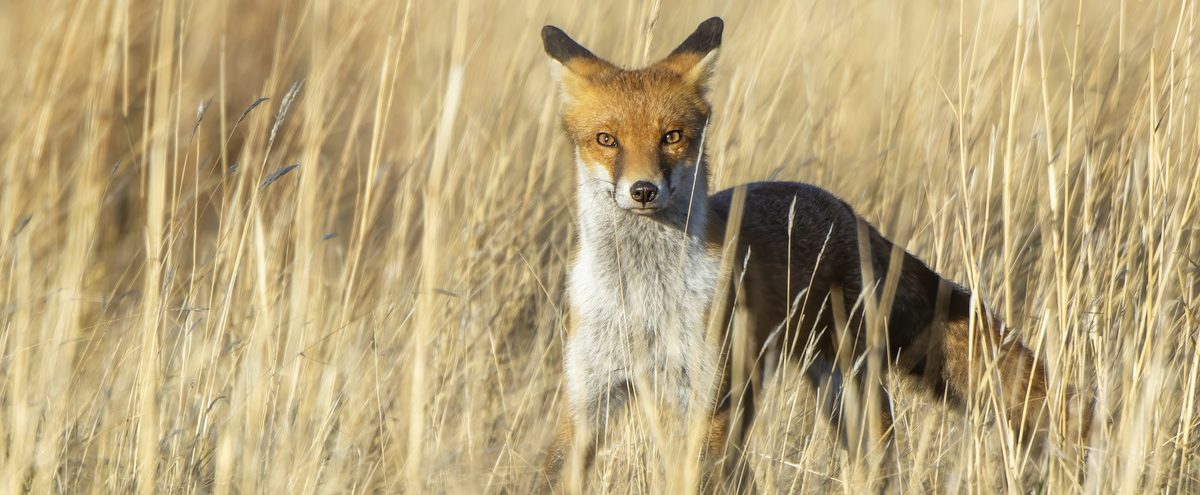
Foxes

European foxes are the most widespread carnivore in the world. Originally introduced to Australia in the 1850s, they spread rapidly and are now found in all states and territories. Foxes are opportunistic predators and scavengers that pose a risk to livestock and native animals.
In Australia, the red variation of the fox is the most common. They are usually a reddish-brown colour with a whitish-grey chin, chest and belly, with black lower legs and ears. They have a narrow chest, long legs, and a bushy tail that is tipped in white. Their size can vary from 45 - 90 cm long and from 3 to 14 kg in weight. They breed between June and October with litter sizes ranging from 1 to 12 pups, although averaging 3 to 6 pups usually.
Foxes are predominately carnivorous. They are an opportunistic predator but also great scavengers, consuming dead flesh and rubbish, plus a range of fruits, vegetables, eggs, and insects when they are available.
Foxes are wary by nature and will usually be seen foraging at night as they are nocturnal. They are known to be sly and sneaky, even stealing shoes and washing from residential gardens. Foxes are territorial, marking their territory with urine which can become quite smelly. If a fox is removed from its territory, another will move in very quickly. During their winter mating season, foxes can be heard making a distinct screaming sound.
Where are foxes found?
Foxes are found in a variety of habits, from arctic tundra to desert, and urban and rural environments. Their highest densities are usually in human-dominated habitats due to plenty of food and shelter being available.
Foxes are found throughout the Murraylands and Riverland, particularly where food and habitat are available. Peri-urban areas and agricultural lands are where most complaints and concerns come from within the region.

What are the impacts of foxes?
Foxes are an agricultural, environmental and social pest. They have strongly contributed to the decline and extinction of many small to medium-sized rodents, birds, and marsupial species in Australia. As of 1999, they were considered a risk to several threatened species including 14 species of birds, 48 mammals, 12 reptiles, and 2 amphibians. Today, these figures are likely to be much greater.
The combined environmental and agricultural impacts of foxes cost Australia around $230 million each year. Foxes prey on poultry, lambs, calves and kids (goats), causing psychological damage to farmers and pet owners who discover attacked animals. Foxes transmit diseases such as distemper, parvovirus, and mange to humans and pets, and also spread weeds. Buildings and sheds can be damaged by foxes digging underground dens. Dripper lines in orchards can also be damaged by foxes chewing to access water or pups wanting to play.
What are my responsibilities as a landholder?
Foxes are declared in South Australia and are prohibited from being:
- Kept as a pet
- Rescued
- Moved
- Sold
- Released
Landholders are legally obligated to control foxes on their property.
What are the options for controlling foxes?
Control programs for most pest animal species are most effective when a combination of techniques are utilised. Efforts are always more effective when landholders work in collaboration with neighbouring properties.
Baiting
Depending on your situation and criteria met, 1080 or PAPP baiting may be a control option. There are two delivery options for the bait, a dried meat bait or a canid pest ejector. For more information and best practice on this, please see:
Cage trapping
This may be an option in peri-urban areas where other traditional tools may not be suitable - please see:
Den fumigation
This cannot be conducted in an enclosed space, and landholders need to be certain the den is a fox den - please see:
Shooting
This is best used when other control options have already been deployed - please see:
In residential areas there are a number of other strategies that can be employed to reduce the attraction of foxes. These include:
- Don't leave food outside overnight
- Keep garbage and compost bins covered
- Keep pets, poultry and livestock securely fenced or in a fox proof enclosure at night
- Use sensor lights or sprinklers to deter fox activity
How can the landscape board support landholders?
The Murraylands and Riverland Landscape Board can provide expert advice, traps, and baits to landholders in the region. Contact your local district officer to find out more.
